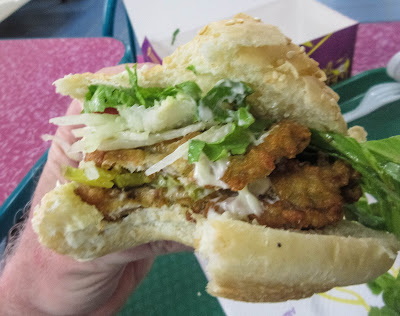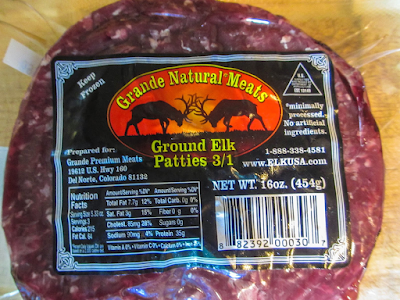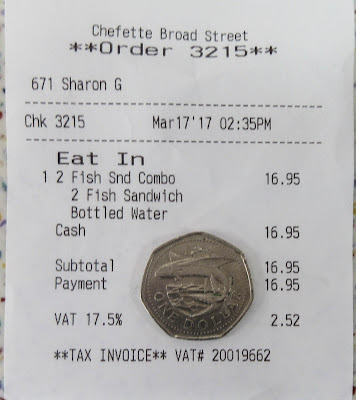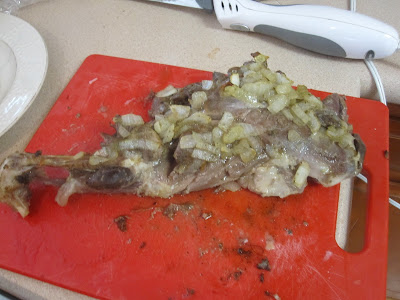ELAND: The eland is a large African antelope that has been domesticated in some areas for its meat. Anshu Pathak of Exotic Meat Market ("EMM") got some domesticated eland from Hawaii. I got a 3.9 lb. roast from him and tried it in various ways: fried, sous vide and grilled. Sous vide made it mushy and grilled had the best taste and texture.
I got an eland osso buco from EMM and cooked it in a crockpot for 12 hours with some beef marrow bones, mushrooms, potatoes, roasted peppers and dirty rice.
ELK: My daughter Rachael's neighbor shot an elk in the Utah elk hunt. Rachael provided me a father's day dinner which included elk bone marrow.
She also shared some elk head cheese her neighbor made (who is a butcher) which included neck meat down to the vertebrae, it was by far the best head cheese I've ever eaten.
A broiled elk medallion from Buckhorn Exchange in Denver, Colorado.
An elk tomahawk steak from Sylvan Lake Lodge in South Dakota.
Elk chorizo from a wild elk shot in Arizona. I used it with hard-boiled quail eggs, fried chicken eggs, guacamole and heirloom tomatoes.
I served ground elk for breakfast during a family reunion in Buena Vista, Colorado with corn, egg and guacamole.
I got a package of elk rib chops from EMM. They were pasture raised and grass fed in New Zealand. President Roosevelt gifted 20 elk (wapiti) from the U.S. to New Zealand in 1909 and they were released on the South Island. I sliced them into individual steaks and cooked them sous vide, then fried them: one batch in camel fat and one batch in butter, along with shishito peppers and an artichoke. They were better than the elk tomahawk steak I had in South Dakota.
A friend shot an elk in Nevada and gave me a backstrap, also known as the loin, which runs the length of the backbone. He also sent me some Bragg Organic Vinaigrette Dressing and Marinade which I marinaded the backstrap in for 3 hours before grilling. It had no gaminess whatsoever and was great.
He also provided me some elk salami. On-line recipes show 4 pounds' of elk roast are mixed with one pound of pork shoulder to provide added fat because the elk is so lean. It was quite strong and some of the best salami I've ever had.
EMU: The emu is the second largest bird, after the ostrich, and is endemic to Australia. Anshu Pathak of EMM also raises them. I got an emu egg from EMM and intended to cook it sunny-side up or over-easy. I put it in a wok with butter. The emu egg is the equivalent of 10 chicken eggs and is 44% yolk compared to a chicken egg which is 35% yolk. Looking at the huge yolk, I quickly determined I needed to scramble it instead and quickly put in some cooked veggies and blue cheese crumbles.
 |
| The yolk to egg-white is huge. |
I got some emu tenderloins from EMM. The tenderloin is a thick strip of meat cut from between the breasts. I cooked them sous vide with some triple garlic teriyaki sauce and minced garlic, then fried them briefly in butter to give them texture.
I also tried emu salami from EMM. It is very dark with good flavor.
FLYING FISH: In Bridgetown, Barbados we had a flying fish sandwich at Cheffete. Flying fish seems to be a big deal there as we also saw a flying fish sandwich advertised at KFC. We noted that the one dollar Barbados coin has a flying fish on it. It is a darker meat and very good.
 |
| Sandwich with a couple of bites out of it. |
We recently had sushi in Yucaipa, California and had a form of sushi with little black seed-like shapes on it. I asked the waiter about it and she told me it was flying fish roe.
FOX: Anshu Pathak of EMM called to tell me he had a gray fox that a trapper had caught in Florida. We eventually had him and his wife, Claudia, and some other guests up for Thanksgiving dinner to eat the fox, as well as a wild turkey that Anshu donated. I brined it for 12 hours and cooked it several different ways, including frying, sous vide and crockpot. Anshu liked the crockpot and I preferred the sous vide. The backbone was the best part of the meat. The brining was not sufficient to remove the gaminess, but the sous vide and crockpot got rid of most of it.
FROG: I've had frog legs in restaurants on several occasions. One was at Lambert's Cafe in Sikeston, Missouri and another was in a Las Vegas restaurant when I was interviewing with a firm there during law school. The first time I made them was using a recipe from Emeril Lagasse.
The next time was with Andrew. We visited Chinatown in Los Angeles and bought three large frogs. We took them to his place, cleaned them and cooked them in flower. The front legs were large enough to eat, as well as the hind legs, but I liked the torso best of all.
Later, at an unusual food dinner with my sister, Merilee, and her family, I found frozen whole frogs at a Chinese market in Salt Lake City. They were two to a package and I bought two packages. My nephew, Isaac, did much of the preparation work. He removed the skin which covered the belly and part of the head, cut off the heads, removed the organs and coated them in flour and fried them.
GEMSBOK: Gemsbok is a species of oryx found in arid regions of southern Africa. In Cape Town, South Africa, we ate at a restaurant called Arnolds and had gemsbok Wellington. It included a gemsbok steak wrapped in bacon, coated with a mixture of mushrooms, herbs and black pepper, sautéed in butter and reduced to a paste, then wrapped in a puff pastry and cooked medium rare. It was one of the best wild game dishes we've had in Africa.
In Namibia we purchased some gemsbok biltong, a version of dried, cured meat which originated in southern Africa.
GRASSHOPPER: Chapulines are grasshoppers eaten in certain parts of Mexico since the 1500s. The grasshoppers are cleaned and washed, then toasted with garlic, lime juice and salt. We purchased some chapulines in Cholula, Mexico from a street vendor and took them to a lunch in Puebla where I had them on a taco with salsa. Not bad.
GOAT: As we've traveled we've discovered that goat is often the meat that is eaten most by the masses, even when you can't find goat on a restaurant menu. I traveled to Monterrey, Mexico with my nephew, John Pedrosa and he took me to a restaurant that he says is known throughout Mexico, called El Rey Del Cabrito, which means "king of the kid (young) goat." John ordered a goat breast, leg, shoulder and head for us. It was amazing.
 |
| Goats roasting on spits over open coals. |
 |
| A plate full of goat pices. |
 |
| Goat breast covered by tasty crispy skin. |
 |
| Goat skull with the eye. |
 |
| Goat eye |
 |
| Goat brain |
For Father's Day my daughter, Rachael, made an all goat dinner for me.
 |
| Sliced cucumber in goat yogurt was the starter. |
 |
| Pizza with king trumpet mushrooms and aged goat cheese, just going into the oven, was next. |
 |
| The cut-up meat was supplemented by gravy. |
 |
| The skin was removed to reveal moist and fatty meat. |
 |
| Goat leg baked for 8 hours in the oven with garlic. |
 |
| A variation of saag paneer with spinach and goat curd on basmati rice. |
 |
| Chocolate goat milk truffles with powdered cocoa. |
 |
| Apricot halves with goat cheese mousse. |
Judy gave me goat milk butter for Christmas. It has the taste and smell of goat cheese, but is not as strong.
For a church fathers and sons outing my friend, Gregg Palmer, provided a goat he owned to help feed the group. Gregg shot the goat in the head with a .22 to kill it and I slit the throat to bleed it and then dressed out the goat.
 |
| Ribs |
 |
| Back legs |
 |
| Front leg |
That night I took the heart and liver home and cut them up and put them in a frying pan with olive olive and a chopped sweet onion. The taste of the liver was quite strong, a little sweet and bitter.
It was a little too rare, so the next day, for the outing, I chopped the liver into smaller chunks and fried it some more. There were a number of takers at the fathers and sons outing that thought it was good.
I marinated the goat with mashed papaya and lime juice and added some sliced beets to give it some color. I cooked the ribs on a gas grill and found the ribs to be so small they were hardly worth eating. The skirt of meat over the outside edge was easy to extract and provided some nice meat.
After marinating, the front legs were baked with two cut-up sweet onions that had been fried in oil.
After marinating the back goat legs I sprinkled on hot Hungarian paprika, pepper and thyme and put each in an infrared cooker.
I carved up the meat from the front and back goat legs and ribs and took them to the fathers and sons outing and tried to reheat them in a warming tray which did not work well. So I put the meat on the large grill cooking hamburgers and hotdogs. We had about 70 people and I'm guessing 70% of them tried the goat, including 6 or 7 that tried the goat heart and liver. I don't recall anyone saying they'd ever tried goat before, so it was a new experience for most there.
I got some ribeye goat steaks from EMM from a goat raised at Anshu Pathak's home. It was a nice cut of meat, so I decided to cook it on indirect heat on a gas grill. Goat has a richer and stronger taste than beef. It was a little tougher than an equivalent steak, but tasted much better.
I got two goat tenderloin steaks from EMM and cooked them on the grill. I cooked them too long, but they were also great. They did not need to be marinated or slow-cooked.
One of Anshu Pathak's workers gave me a goat head from a goat they'd slaughtered at Anshu's farm. I decided to make goat head soup with it. The Rolling Stone's album "Goat's Head Soup" dominated my internet search for recipes. I simmered the goat head for three hours, extracted the meat, including the brain and tongue, with the outer skin removed, and put the meat back in the pot with various root vegetables (potatoes, yellow beats, onions, butternut squash, white corn and carrots, as well as beef bouillon, dried garlic and granulated garlic) for 30 minutes. It was quite good.
Claudia, Anshu Pathak's wife, who is Romanian, made and gave us some goat drob, a traditional Romanian dish served at Easter, usually with lamb, but sometimes with goat. It is similar to Scottish haggis, with the offal, including liver, lungs, spleen, heart and kidney and some other ingredients. The offal is boiled, chopped and mixed with other ingredients and then put in the caul of the goat (the lacy fat that surrounds the organs). The center is a hard-boiled partridge egg. It was wonderful.

























































































I do love goat, and I wonder why Americans are so hesitant to eat it. On the other hand, some of your photos, like the head boiling in the pot, do not make the meat look very appetizing. Also, I remember that emu egg at the beginning of your post. That was fun.
ReplyDelete